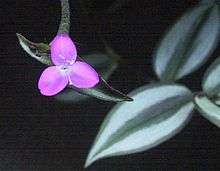Tradescantia zebrina
| Tradescantia zebrina | |
|---|---|
 | |
| Tradescantia zebrina | |
| Scientific classification | |
| Kingdom: | Plantae |
| Clade: | Angiosperms |
| Clade: | Monocots |
| Clade: | Commelinids |
| Order: | Commelinales |
| Family: | Commelinaceae |
| Subfamily: | Commelinoideae |
| Tribe: | Tradescantieae |
| Subtribe: | Tradescantiinae |
| Genus: | Tradescantia |
| Species: | T. zebrina |
| Binomial name | |
| Tradescantia zebrina (Schinz) D. R. Hunt | |
| Synonyms | |
|
Tradescantia pendula | |
Tradescantia zebrina, formerly known as Zebrina pendula, is a species of spiderwort more commonly known as an inchplant[1] or wandering jew. The common name is shared with closely related varieties T. fluminensis and T. pallida. Tradescantia zebrina is native to Mexico, Central America and Colombia, and naturalized in parts of Asia, Africa, Australia, South America, and various oceanic islands.[2][3][4]
Description
Tradescantia zebrina has attractive zebra-patterned leaves, the upper surface showing purple new growth and green older growth parallel to the central axis, as well as two broad silver-colored stripes on the outer edges, with the lower leaf surface presenting a deep uniform magenta. The leaves are bluish green and usually have two longitudinal stripes that are silvery on the surface and purple on the underside. The leaf sheaths are thin and translucent, 8 to 12 mm long and 5 to 8 mm wide, at the mouth they are long, otherwise glabrous or slightly hairy.
The low-lying, slightly succulent, perennial, herbaceous plant often forms dense mats or colonies. This is done primarily by natural formation of sinkers. On the nodules of the shoot are root approaches, from which roots develop in permanent contact with water or a sufficiently moist substrate under favorable conditions within a day. The shoots are glabrous or hairy. The stalked, parallel-veined leaves are mostly ovate, 4 to 10 cm long and 1.5 to 3 cm wide, pointed towards the tip, rounded to the base. The upper surface is glabrous to mildly hairy, the underside hairless to averagely hairy, ciliate towards the leaf base. The structure of the flower - usually from the three pink petals and the white sexual organs - is similar to that of the other Tradescantia, but unlike what happens in those, the plant branches off thanks to new buds whose attachment starts below that of the leaf (and not above)
The flowers are in groups, supported by two large foliage-like, narrow, ciliate bracts. The hermaphrodite, radial-symmetrical flowers are threefold. The three overgrown sepals are 2 to 3 mm long. The three only grown at the base petals are ovate-blunt, pink to purple and 5 to 9 mm long. The six equally sized stamens are violet hairy. Three carpels have become a top permanent ovary grown. They form capsule fruits that contain gray-brown seeds.[5]
Habitat
The plant grows in thickets in the wetland and rainforest , often on stones in shady and open areas or on river banks at altitudes of 2000 meters or below, but mainly at lower altitudes. The plant is not frost-resistant and is therefore kept in the winter months as a houseplant. Usually a hanging plant. [6]
Uses
Cultivation
It is commonly available and used as a houseplant and groundcover, aggressively colonizing new areas when disturbed. Propagated by cuttings, this plant can be moved or manipulated easily as its runners cling lightly to the ground (if used as cover). It tends to become an invasive species if not properly maintained.
This plant has gained the Royal Horticultural Society's Award of Garden Merit.[7]
Medicinal
It is used in southeast Mexico in the region of Tabasco, as a cold herbal tea, which is named Matali.[8] Skin irritation may result from repeated contact with or prolonged handling of the plant — particularly from the clear, watery sap (a characteristic unique to T. zebrina as compared with the other aforementioned types).
Invasiveness
Classified as a Category 1b Invasive Species in South Africa,[9] and thus in South Africa it may no longer be planted or propagated, and all trade in their seeds, cuttings or other propagative material is prohibited. They may not be transported or be allowed to disperse, both in rural and urban areas.[10][11] It is also an invasive species in Galapagos Islands.[12]
Varieties
- Tradescantia zebrina var. flocculosa (G.Brückn.) D.R.Hunt - tropical Mexico, Guatemala, Honduras
- Tradescantia zebrina var. mollipila D.R.Hunt - tropical Mexico
- Tradescantia zebrina var. zebrina - most of Mexico from north to south, Central America, Colombia
References
- ↑ "Tradescantia zebrina". Natural Resources Conservation Service PLANTS Database. USDA. Retrieved 14 December 2015.
- ↑ "World Checklist of Selected Plant Families: Royal Botanic Gardens, Kew". apps.kew.org.
- ↑ Nelson Sutherland, C.H. (2008). Catálogo de las plantes vasculares de Honduras. Espermatofitas: 1-1576. SERNA/Guaymuras, Tegucigalpa, Honduras.
- ↑ CONABIO. 2009. Catálogo taxonómico de especies de México. 1. In Capital Nat. México. CONABIO, México D.F..
- ↑ Paul C. Standley and Julian A. Steyermark: Flora of Guatemala , Field Museum of History Botanical Series, Volume 24, Part III, Chicago, USA, 1952.
- ↑ Fritz Encke: Plants for Room and Balcony , Eugen Ulmer, Stuttgart, 1964.
- ↑ "RHS Plant Selector - Tradescantia zebrina". Retrieved 5 July 2013.
- ↑ "Wandering Jew / Spiderwort". Project Noah. Retrieved 2016-09-25.
- ↑ http://www.invasives.org.za/legislation/what-does-the-law-say
- ↑ http://www.arc.agric.za/arc-ppri/Pages/Weeds%20Research/Legal-obligations-regarding-invasive-alien-plants-in-South-Africa-.aspx
- ↑ http://www.environment.co.za/documents/legislation/NEMA-National-Environmental-Management-Act-Biodiversity-10-2004-G-26436.pdf
- ↑ http://www.darwinfoundation.org/datazone/media/pdf/64/GR_64_2006_Renteria%26Buddenhagen_Invasive_plants_in_scalesia%20forest.pdf
External links
| Wikimedia Commons has media related to Tradescantia zebrina. |
- Standard Data Report: Tradescantia zebrina - Integrated Taxonomic Information System
- Taxonomy Browser: Tradescantia zebrina - National Center for Biotechnology Information (US National Institutes of Health)
- Desert Tropicals - Informational database on common gardening plants, based out of Phoenix, Arizona, USA
- Tradescantia zebrina - WikiSpecies page